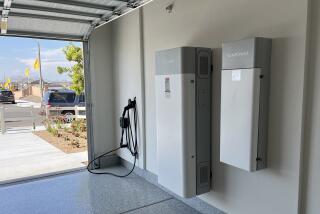Opponents of PG&E ‘smart meters’ stand firm
Pacific Gas & Electric Co.’s plan to install ‘smart meters’ in this affluent Bay Area community of eco-friendly homes, yoga studios and organic restaurants has unleashed a torrent of anger among customers who fear the devices will expose them to hazardous pulses of electromagnetic radiation.
Hundreds of Fairfax residents have posted red-and-white “Smart meter not here” signs beside their mechanical meters as a warning to PG&E technicians. A few have secured their spinning-dial meters with gates, cages and padlocks.
“There’s no way they’re taking my meters away, and I don’t want them putting things on my property that I don’t want,” said local Realtor Diane Hoffman, fastening a padlock onto a wooden gate guarding her home meter.
The power company, which has about 10 million customers from Bakersfield to Eureka, has installed nearly 8 million radio-controlled digital smart meters since last summer.
The meters transmit data about electrical use over wireless networks to the utility company, enabling it to assess power demands and make adjustments to prevent blackouts, and giving consumers real-time data to help them reduce consumption. They are an integral part of efforts to create a “smart grid” nationwide that uses electricity more efficiently and can better accommodate alternative energy sources.
Nonetheless, finishing the installation in California won’t be easy. The new meters have galvanized an unusual alliance of environmentalists, city planners, private land owners and politically conservative activists worried about the health effects, accuracy and privacy of smart meters, as well as jurisdictional conflicts with PG&E.
The “tea party” recently hosted a gathering of smart-meter opponents in Santa Barbara.
Protesters also gathered this month in Sacramento and at PG&E’s San Francisco headquarters. Joshua Hart, director of a group called Stop Smart Meters!, said participants included “people with heartbreaking personal stories to tell about sleeping in the parking lots of churches and department stores to escape the bursts of electromagnetic radiation that have made them ill and fearful.”
The cities of Fairfax, Capitola and Watsonville and Marin and Santa Cruz counties have approved emergency moratoriums on smart meters. The Fairfax Town Council plans to renew its one-year moratorium in this community of about 7,500 people.
“We refer to our moratorium as a cold truce in a low-intensity conflict,” said Mayor Larry Bragman, a local trial lawyer. “We’ve had ordinances on the books since 1997 requiring all proposed wireless communications projects to go through the town’s planning processes. PG&E completely circumvented all of that.”
He added, “The mayor and police will show up if they try and install a smart meter in town.”
Smart meters operate at low power and in the radio frequency portion of the electromagnetic spectrum. At these levels, radio signals from smart meters are unlikely to produce harmful thermal effects, according to a recent study by the nonpartisan, nonprofit California Council on Science and Technology, which advises state government on technology issues. The study determined that radio frequency emissions from smart meters fall well within federal safety standards for cellphones and microwave ovens.
Citing that study and others, PG&E says it would take 1,000 years of living next to a smart meter to get the same exposure to radio frequency emissions cellphone users get in just one month.
But non-thermal effects of absorbed radio frequency emissions on human health remain unclear. Complaints of “electromagnetic stress” blamed on cellphones and smart meters include such symptoms as headaches, fatigue and irritability.
Studies are being conducted to understand possible non-thermal effects, particularly any cumulative impact of living next to a network of smart meters.
PG&E spokesman Jeff Smith said local moratoriums are invalid. “PG&E does not and will not honor any moratorium because the smart-meter program falls under the jurisdiction of the California Public Utilities Commission,” he said.
But CPUC officials forced the utility to come up with an alternative plan for customers who object to the technology. In March, PG&E submitted a proposal that would allow customers to opt out of the program, provided they pay $135 to $270 to have the device’s radio transmitter disconnected. Those customers would be charged $14 to $20 per month for a technician to read their meter.
Ed Segal, chief executive of the Marin County Assn. of Realtors, described PG&E’s proposal as “extortion by a monopoly.”
Pending a final ruling on the proposal by the CPUC, customers who object to smart meters will be allowed to defer their installations, PG&E said.
“We’re trying hard to do a better job of reaching out to our customers in terms of explaining the smart-meter program and its benefits,” Smith said. “The problem was that when we started rolling out the program, we looked at it as just a hardware replacement job. We realized, not quickly enough, that the issue was very personal to some customers.”
David Owens, an executive vice president of the Edison Electric Institute, a lobbying arm of the utility industry, is on the same page.
“The pushback to smart meters has come from portions of California and Maine, and that’s because we haven’t done a good job of educating consumers,” he said. “We don’t want it to reach an epidemic stage, so we’re conducting surveys and focus groups and learning a lot about how to take the anxiety and sensational stuff out of this program.”
“I don’t even use the phrase ‘smart meter’ anymore,” he said. “I just call them automated metering devices.”
Barry Smith, executive director of a fledgling organization called Alliance for Human and Environmental Health, said Owens misses the point.
“The key issue for the CPUC to decide is whether entire communities have a right to opt out of the smart-meter program,” Smith said. “Do the laws on the books in our towns and counties matter? Or does industry alone determine outcomes for our citizens?”
More to Read
Start your day right
Sign up for Essential California for news, features and recommendations from the L.A. Times and beyond in your inbox six days a week.
You may occasionally receive promotional content from the Los Angeles Times.







